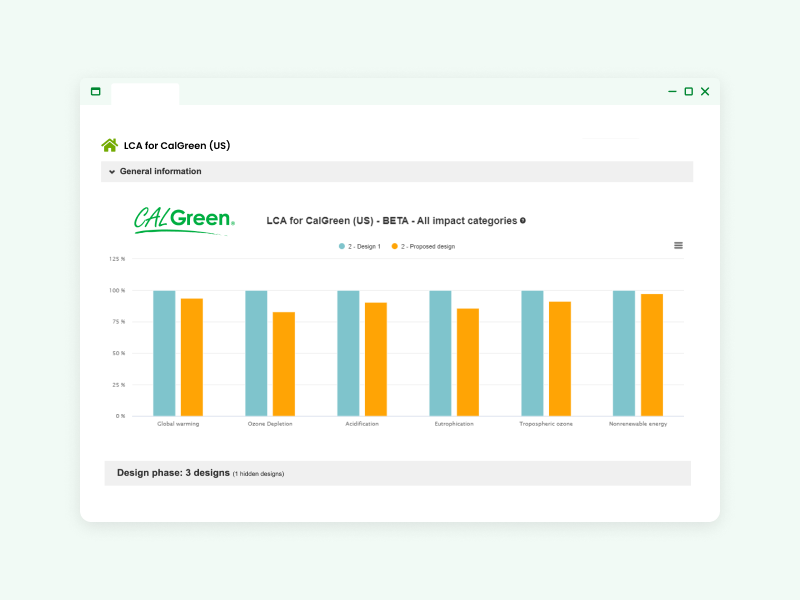
California’s CALGreen building code, also known as Title 24, Part 11, is setting a precedent for sustainable construction as the first U.S. state-mandated green building code. Here’s what you need to know.
What is CALGreen?
CALGreen is California's green building code (Title 24, Part 11) — the first state-mandated green building code in the United States. Officially known as the California Green Building Standards Code, it applies to the planning, design, operation, construction, use, and occupancy of all newly constructed or significantly renovated buildings or structures statewide. Title 24, Part 11, specifically addresses embodied carbon in buildings, effective as of July 1, 2024.
3 ways to comply with new Title 24, Part 11 CALGreen regulations
Key components of CALGreen
CALGreen's mandate spans five areas:
|
1. Planning and design Site development
|
2. Energy efficiency Compliance with Title 24, Part 6, of the California Energy Code
|

|
|
3. Water efficiency and conservation Indoor water use
Outdoor water use
|
4. Material conservation and resource efficiency Building material
Construction waste reduction
|
5. Environmental quality Indoor air quality
Pollutant control
|
Covered projects
Title 24, Part 11 covers new residential and non-residential buildings, and significant additions and alterations. It applies to:
- All new construction (residential & non-residential)
- Residential alterations/additions that increase the building's conditioned floor area
- Non-residential additions greater than 1000 feet
- Non-residential alterations valued at $200,000 or more
CALGreen tiers
CALGreen includes both mandatory measures and voluntary tiers (Tier 1 and Tier 2). These tiers encourage higher sustainability:
- Mandatory measures: Apply to all projects, setting minimum sustainable goals.
- Voluntary tiers: Add additional requirements, adopted optionally by local jurisdictions.
- Tier 1: Adds more requirements beyond mandatory measures.
- Tier 2: Further increases sustainability requirements.
July 2024 update to Title 24 — embodied carbon
Starting July 1, 2024, CALGreen requires non-residential building projects exceeding 100,000 sf and school projects exceeding 50,000 sf to address the climate impact of building materials. This is the first statewide embodied carbon building code in the US. Building materials account for 11% of greenhouse gasses (GHG) worldwide. The focus has now shifted to delivering lower embodied carbon projects.

3 pathways to compliance
The buildings outlined above must meet one of three compliance pathways for embodied carbon:
Pathway 1: Building reuse
- Mandatory: Reuse 45% of building structure and enclosure.
- Tier 1: Reuse 75% of the structure and enclosure.
- Tier 2: Reuse 75% of structure and enclosure plus 30% of interior non-structural elements.
The global buildings sector continues to grow, with global floor area expected to double by 2060. New buildings contribute to 11% of worldwide GHG, so building reuse is extremely beneficial.
Requirements for building reuse: Maintain a minimum of 45% combined of the existing building's primary structural elements (foundations, columns, beams, walls, floors, lateral elements) and enclosure (roof framing, wall framing, exterior finishes). The calculation does not include window assemblies, insulation, and portions of buildings deemed structurally unsound or hazardous.
Pathway 2: Performance pathway, using a whole building life-cycle assessment (WBLCA)
Conduct a 60-year cradle-to-grave whole building LCA (excluding operating energy), with the following results:
- Mandatory: 10% lower emissions than baseline.
- Tier 1: 15% reduction from baseline.
- Tier 2: 20% reduction from baseline. Show global warming potential (GWP) analysis.
WBLCA evaluates the environmental impacts of a building throughout its entire life-cycle. The steps include:
- Goal & scope: Define project goals and scope, focusing on a 60-year lifetime and 10% carbon reduction from baseline.
- Inventory: Quantify materials used in the project by type.
- Impact assessment: Calculate the environmental impact, focusing on carbon emissions.
- Results interpretation: Analyze and report findings to ensure compliance with Title 24, Part 11.
How to calculate a baseline for your project
Easily create reference buildings using One Click LCA’s early design tool, Carbon Designer 3D. Create and design options with just building size and type, calculate baseline carbon emissions, and quickly find ways to reduce emissions.
Pathway 3: Prescriptive pathway, using environmental product declarations (EPDs) for listed materials
To achieve this pathway, you'll need to prove compliance through environmental product declarations (EPDs). EPDs quantify the environmental impact of materials throughout their life-cycle. According to CALGreen, you will need to provide EPDs for the following materials on your building project: steel, glass, mineral wool, concrete, with lower than specified GWP.
The specified limit is 175% of the industry average GWP for that material. The standard for CALGreen is the same as the Buy Clean California Act, with the addition of ready-mixed concrete.
- Mandatory: 175% of industry average global warming potential limits.
- Tier 1: 150% of industry average global warming potential limits.
- Tier 2: At industry average global warming potential limits.
In the U.S., there are two widely known and commonly used types of EPDs: Industry average and product-specific. Industry average EPDs are developed by organizations (e.g. National Ready Mixed Concrete Association). Data is collected from various constituents and the average data is shared through an EPD. Manufacturers publish product-specific EPDs for their specific products. To fulfill this pathway of CALGreen you will need to provide product-specific EPDs.
Steps for submitting EPDs:
- Understand the requirements:
- Review the project specifications, particularly Division 1 (General Requirements) and the relevant technical divisions, to understand the EPD requirements.
- Identify all materials that require EPDs under the CALGreen prescriptive pathway.
- Procurement planning:
- Develop an action plan for procuring materials that meet Title 24, part 11 requirements.
- Engage with suppliers early to ensure they can provide the necessary product-specific EPDs or use One Click LCA’s Materials Compass tool to check available EPDs to create a shortlist of suppliers.
- Ensure suppliers understand the need for third-party verified (type 3) EPDs.
- Collection of EPDs:
- Obtain EPDs from suppliers, or use One Click LCA’s global database for all relevant materials. Ensure that these EPDs are product-specific and are third-party verified.
- Verify that the EPDs include all required information and cover all mandatory impact categories including the global warming potential (GWP).
- Documentation preparation:
- Organize the EPDs according to the materials they correspond to.
- Prepare a summary document that lists all materials requiring EPDs with their respective EPDs and GWP values. This summary should cross-reference the specific sections in the project specifications.
- EPD submittal package:
- Create a comprehensive EPD submittal package. If you use One Click LCA, this EPD package is generated automatically. This package should include:
- Cover letter: Briefly explain the purpose of the submission and list the materials included.
- Summary document: A detailed list of materials, their respective EPDs, and GWP values.
- Individual EPDs: Copies of the actual EPDs, ensuring they are clearly labeled and organized for easy reference.
- Create a comprehensive EPD submittal package. If you use One Click LCA, this EPD package is generated automatically. This package should include:
- Submission process:
- Submit the EPD package as part of the initial material submittal process, adhering to the project's specified format and deadlines.
- Ensure the submission is included in the permitting documentation, as CALGreen requires.
- Review and approval:
- Coordinate with the project’s design team and sustainability consultants to review the EPD submission.
- Address any feedback or requests for additional information promptly to avoid delays.
- Progress tracking:
- Maintain records of all submitted EPDs and track the approval status.
- Ensure that any additional EPDs needed due to material substitutions or changes are submitted and approved.
One Click LCA is an all-inclusive source for CALGreen’s EPD requirements which include:
- A comprehensive global database with all available EPDs
- Product-specific or factory-specific EPDs
- Third-party verified EPDs
- Automatic EPD package creation
Incentives for achieving higher tiers
Incentives for achieving Tiers 1 and 2 depend on the jurisdiction and specific programs available. Some general incentives include:
- Financial incentives: Rebates, grants, and tax credits
- Expedited permitting: Faster permitting processes
- Reduced fees: Lower building permit fees
- Marketability: Increased market value and appeal
- Operational savings: Lower energy and water costs
- Improved environmental impact: Support for climate goals
- Recognition and certification: Awards and additional green building credentials

One Click LCA's CALGreen tool
One Click LCA's CALGreen-specific tool is designed to help projects comply with Title 24, Part 11 regulations. This tool simplifies compliance by:
- Integrating with Revit and other building information modeling (BIM) and energy modeling tools, via 20+ integrations
- Automating the calculation of embodied carbon reductions
- Making it easy to document and report compliance with CALGreen specific reporting tools
It features the world's largest database of material EPDs and can generate comparative LCA documents to align with CALGreen and LEED requirements.
Summary
Title 24's embodied carbon regulations took effect on July 1, 2024. California is raising the bar for embodied carbon reduction in the building sector. These new standards require developers to follow one of three compliance pathways: Building reuse, whole building life-cycle assessment (WBLCA), or environmental product declarations (EPDs).
One Click LCA's CALGreen tool simplifies the process by integrating with Revit, other BIM, and energy models, automating embodied carbon calculations, and streamlining documentation and reporting. By utilizing this tool, architects and builders can easily meet the new standards, reducing the environmental impact of their construction projects and supporting California's climate goals.
CALGreen tool
See the CALGreen tool in action
This self-guided product tour will walk you through the key features of the CALGreen tool and show you how easy compliance can be.

Carbon Experts Newsletter
Industry news & insights — straight to your inbox
Want to learn more?
Laura Drury • Nov 14 2024
Justyna Michalik-Minken • Sep 30 2025
Asha Ramachandran • Feb 07 2025
Justyna Michalik-Minken • Apr 09 2025
